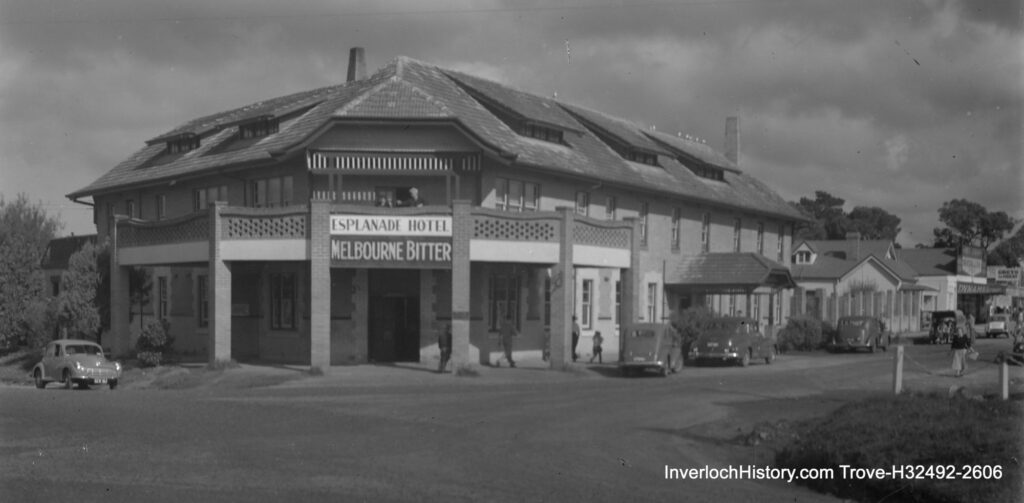This not a description of the mine, but of its relevance and interest to the development of Inverloch and district.
Let’s start with the differences between Black and Brown Coal.
Black Coal
Has a low moisture content so it burns well, leaving a small amount of ash. It was a premier fuel for household heating, industry and the railways. There are varying grades of black coal, with the best being reserved for the railways and other steam driven industrial power plants. Households usually received the lower grade coal.
Brown Coal
In its raw state has 70% moisture content, and is grossly inferior to black coal. It burns poorly, leaving a lot of ash. The large deposits of brown coal were known and mined at Morwell in 1887, but in small quantities. The great development in the Latrobe Valley came in the early 1920’s, with Sir John Monash leading its development as Chairman of the then State Electricity Commission.
Brown Coal Briquettes
This is a process that dries and compresses brown coal with which we Victorian’s are highly familiar. They burn well, but still leave a high ash content. Interestingly, the first briquettes were made in 1892, but technical problems and the competition from cheaper black coal closed the factory down. Production resumed in the early 1930’s, when the Victorian Government set up a factory in Morwell, which continued until the early 21st century.
Where was Black Coal found?
The first report of black coal in Victoria came as early as the 1820’s, when the explorers Hume and Hovell found a seam of black coal at Cape Paterson, but it was not until the famous Gold Rush of the early 1850’s that government became interested in where black coal could be commercially mined. None was found despite various geological surveys. As early as 1858, black coal was discovered in the Wonthaggi area, but yet again was too poor a quality to mine. A thorough search of South Gippsland in the 1890’s proved fruitless for the viability of development a black coal industry, despite various points around Inverloch showing seams and signs of coal, in such places as Townsend Bluff and Eagles Nest. Even today, pieces of black coal can be found in the very same places.
Why was Wonthaggi developed for its Black Coal?
In early 1909, Victorian industry and public transport suffered a major and most serious shortage of coal because of a long strike in the NSW coalfields. The long journey from the NSW coalfields to Victoria added to the overall costs. The change of railway gauge at Albury meant that the coal had to be re-loaded onto Victorian wagons with its wide 5′ 3″ gauge. The Victorian Government decided to ensure some degree of self sufficiency for this vital fuel for the state, by opening a coal mine at Wonthaggi. However, coal from NSW was still required as Wonthaggi coal did not cover the requirements within Victoria. It should be remembered that there was no major electricity industry nor alternatives to black coal. Brown coal in the Latrobe Valley had still to be developed on a major scale, so the State had a major problem on its hands. To operate Victorian Railways steam trains required 1,000 tons of coal per day. As all trains were steam driven this required an enormous, regular and continued supply of coal. Consequently, Victoria had to temporarily reduce their passenger services and limit goods trains throughout the State. This was embarrassing politically and highly damaging to the Victorian economy.
What happened?
The Wonthaggi coal mine opened in late 1909 with the new train line from Nyora, on the Great Southern Railway, yet to be completed. The result was that the mined black coal was sent to Inverloch, loaded onto boats and shipped to Melbourne. This made the price of coal very high. Happily the new railway reached Wonthaggi in February. It was built in a record 18 weeks, so the Inverloch trade ceased. In the meantime, land developers hoping to see Inverloch develop its coal trade, described in their brochures that Inverloch was “the New Newcastle of the south”. As we know now, this did not happen. The peace and quiet of Inverloch returned and many developers had to swallow their ridiculous words. It should be noted that pressure was applied to extend the railway to Inverloch. This effort was tried several times. The developers, in their fervor to show that every facility and service was available or possibly arriving, advertised a train line to Inverloch. The Society has copies of these developers posters, which includes the pictorial illusions of what might have been.
And the Wonthaggi Black Coal?
Was generally of a poor grade, compared to the high quality from the NSW coalfields. The coal seams were narrow, meaning that physically mining it was very hard. Men had to often lie on their sides with their picks and work in confined space, whereas the NSW coal seams were 8 to 12 feet thick, making work somewhat easier. The Wonthaggi mine produced 17 million tons of black coal in its lifetime from 1909 to 1968.
Conditions at the Wonthaggi Mine
It would be fair to say that working underground, especially in a coal mine, would have to be one of the most dangerous, physical, filthy, dirty jobs one could imagine. The Wonthaggi mines (Powlett River Coal Mines), were no different despite the new conditions the miners gained from the government. These new conditions were regarded as a standard for all coal mines, and represented a marked improvement. The men were no longer at the mercy of the private owners. This is in marked contrast to the mines of Outtrim, Jumbunna and Korumburra which were privately owned, where the miners were treated harshly with little or no protections.
With the opening of the Wonthaggi mine and the conditions won, the mines at nearby Outtrim, Jumbunna and Korumburra, over the years closed as the men and their families simply moved to Wonthaggi for greater surety of employment and conditions. Many even brought their houses with them to Wonthaggi and lnverloch. Even other buildings were sold and moved. such as the Uniting Church in William Street, which originally was the Presbyterian Church at Outtrim.
As the years have passed. many of these old houses have been demolished. and so another South Gippsland community historical link is lost. The very same fate has come to pass with the loss of the Wonthaggi, Outtrim and Great Southern Railway lines, all of which, in some way or other, contributed to the life and future of lnverloch.
Success of the Wonthaggi Railway Line
Originally known as the Powlett River Railway, with its arrival in Wonthaggi in 1910, lnverloch people now had a regular and shorter connection to the popular, convenient and speedy railway system, especially to Melbourne.
Despite the railways short life (1910 to 1968), it would have to be one of the most successful of Victoria’s railways.
Carrying the essential coal, with connections to the State Coal mine, plus mines at nearby Dudley and Kirrak, which was the last to close, plus the added benefit of general goods traffic and passenger traffic, the Wonthaggi line, despite its slow demise, rates highly in Victorian history.
In 1926 the mines produced 2,435 tons of coal per day, with the railways buying 90% of it. The rest went to varying Victorian industries.
Passenger journeys (by steam train) in 1926 took around four hours, but with the introduction of diesel rail motors in the 1950’s the time taken was reduced to three and a quarter hours.
By 1960, with the ownership of cars by many people, the railways popularity declined. The railway finally closed in November 1978. It is now the Bass Coast Rail Trail.
by John Hutchinson. May 2018
Coal mining at Outtrim:

